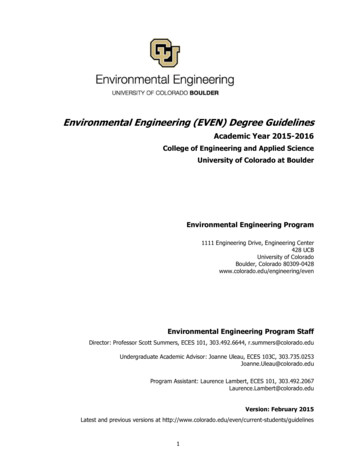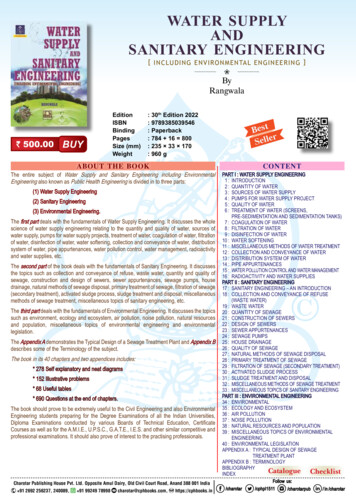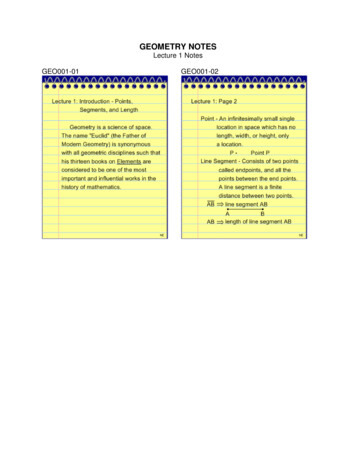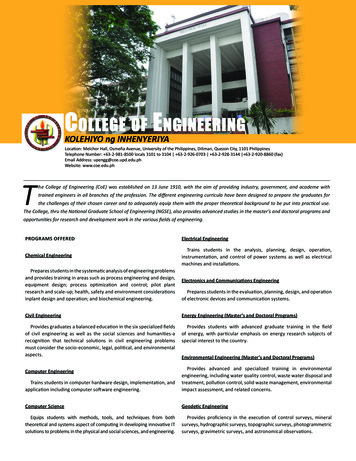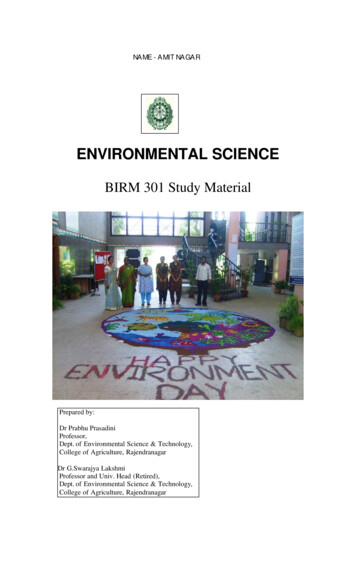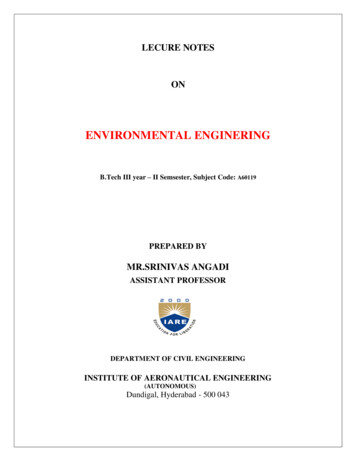
Transcription
LECURE NOTESONENVIRONMENTAL ENGINERINGB.Tech III year – II Semsester, Subject Code: A60119PREPARED BYMR.SRINIVAS ANGADIASSISTANT PROFESSORDEPARTMENT OF CIVIL ENGINEERINGINSTITUTE OF AERONAUTICAL ENGINEERING(AUTONOMOUS)Dundigal, Hyderabad - 500 043
INSTITUTE OF AERONAUTICAL ENGINEERING(AUTONOMOUS)Dundigal, Hyderabad - 500 043CIVIL ENGINEERINGLECTURE NOTESSYLLABUS:Unit –I:Protected Water Supply - Population Forecasts, Design Period - Water Demand - Types Of Demand Factors Affecting Fluctuations - Fire Demand - Storage Capacity - Water Quality And Testing - DrinkingWater Standards Comparison From Quality And Quantity And Other Considerations – Intakes Infiltration Galleries, Confined And Unconfined Aquifers, and Distribution Systems - Requirements Methods And Layouts.Unit –II:Layout and general outline of water treatment units - sedimentation, uniform settling velocity –principles - design factors - surface loading - Jar test- optimum dosage of coagulant – coagulation flocculation, clarifier design - coagulants - feeding arrangements. Filtration – theory - working of slowand rapid gravity filters - multimedia filters - design of filters - troubles in operation comparison of filters- disinfection - Types of disinfection - theory of chlorination- chlorine demand and other disinfectiontreatment methods. Distribution systems - types of layouts of distribution systems - Design ofdistribution systems - Hardy Cross and equivalent pipe methods, Service reservoirs – joints, valves suchas sluice valves, air valves, scour valves and check valves water meters - laying and testing of pipe linespump house.Unit –III:Conservancy and water carriage systems - sewage and storm water estimation - type of concentration storm water over flows combined flow - characteristics of sewage, cycles of decay - decomposition ofsewage, examination of sewage, B.O.D. and C.O.D. equations - design of sewers - shapes and materials sewer appurtenances manhole - inverted siphon - catch basins - flushing tanks - ejectors, pumps and pumphouses- house drainage - components requirements - sanitary fittings - traps- one pipe and two pipesystems of plumbing – ultimate disposal of sewage – sewage farming – dilutionUnit –IV:Lay out and general outline of various units in a waste water treatment plant –primary treatmentdesign of screens –grit chambers –skimming tanks-sedimentation tanks-principles and design ofbiological treatment –trickling filters- standard and high rate.Unit –V:Construction and design of oxidation ponds –sludge digestion tanks –factors effecting –design ofdigestion tank –sludge disposal by drying –septic tanks working principles and design-soak pits. Ultimatedisposal of waste water- self-purification of rivers- sewage farming.TEXTBOOKS:1. Water Supply And Sanitary Engineering By G .S. Birdi, Dhanpat Rai & Sons Publishers2. Water Supply Engineering, Vol 1, Waste Water Engineering, Vol II , BC Punmia, Ashok Jain &Arun Jain, Laxmi Publications Pvt Ltd .
3. Elements of Environmental Engineering by K .N. Duggal, S. Chand Publishers.Reference Books:1. Water and waste water technology by Mark J Hammar2. Water and waste water technology by steel3. Water and waste water engineering by Fair Geyer and Okun4. Waste water treatment- concepts and design approach by G. L. Karia and R. A .Christian, PHI5. Waste water engineering by Metcalf and eddy6. Unit operations in environmental engineering by R. Elangovan and M.K Saseetharan, New ageinternational.
Unit-1Raw Water SourceThe various sources of water can be classified into two categories:1. Surface sources, such asa. Ponds and lakes;b. Streams and rivers;c. Storage reservoirs; andd. Oceans, generally not used for water supplies, at present.2. Sub-surface sources or underground sources, such asa. Springs;b. Infiltration wells ;andc. Wells and Tube-wells.Water Quantity EstimationThe quantity of water required for municipal uses for which the water supply scheme has to be designedrequires following data:1. Water consumption rate (Per Capita Demand in liters per day per head)2. Population to be served.Quantity per capita demand x PopulationWater Consumption RateIt is very difficult to precisely assess the quantity of water demanded by the public, since there are manyvariable factors affecting water consumption. The various types of water demands, which a city mayhave, may be broken into following classes:Water Consumption for Various Purposes:Types of estic es and 53020-90451045-1506225Fire Fighting Demand:The per capita fire demand is very less on an average basis but the rate at which the water is required isvery large. The rate of fire demand is sometimes treated as a function of population and is worked outfrom following empirical formulae:AuthorityFormulae (P in thousand)Qfor1lakhPopulation)1American InsuranceAssociation2 Kuching’s FormulaQ (L/min) 4637 P (1-0.01 P)41760Q (L/min) 3182 P318004
3Freeman's FormulaQ (L/min) 1136.5(P/5 10)35050MinistryofDevelopmentFormulaQ (kilo liters/d) 100 P for P 50000316234UrbanManualFactors affecting per capita demand:a. Size of the city: Per capita demand for big cities is generally large as compared to that forsmaller towns as big cities have sewered houses.b. Presence of Industries.c. Climatic conditions.d. Habits of people and their economic status.e. Quality of water: If water is aesthetically & medically safe, the consumption will increase aspeople will not resort to private wells, etc.f. Pressure in the distribution system.g. Efficiency of water works administration: Leaks in water mains and services; and unauthorizeduse of water can be kept to a minimum by surveys.h. Cost of water.i. Policy of metering and charging method: Water tax is charged in two different ways: on the basisof meter reading and on the basis of certain fixed monthly rate.Fluctuations in Rate of DemandAverage Daily per Capita Demand Quantity Required in 12 Months/ (365 x Population)If this average demand is supplied at all the times, it will not be sufficient to meet the fluctuations. Seasonal variation: The demand peaks during summer. Firebreak outs are generally more insummer, increasing demand. So, there is seasonal variation.Daily variation depends on the activity. People draw out more water on Sundays and Festivaldays, thus increasing demand on these days.Hourly variations are very important as they have a wide range. During active householdworking hours i.e. from six to ten in the morning and four to eight in the evening, the bulk of thedaily requirement is taken. During other hours the requirement is negligible. Moreover, if a firebreaks out, a huge quantity of water is required to be supplied during short duration,necessitating the need for a maximum rate of hourly supply.So, an adequate quantity of water must be available to meet the peak demand. To meet all thefluctuations, the supply pipes, service reservoirs and distribution pipes must be properly proportioned.The water is supplied by pumping directly and the pumps and distribution system must be designed tomeet the peak demand. The effect of monthly variation influences the design of storage reservoirs andthe hourly variations influences the design of pumps and service reservoirs. As the population decreases,the fluctuation rate increasesMaximum daily demand 1.8 x average daily demandMaximum hourly demand of maximum day i.e. Peak demand 1.5 x average hourly demand 1.5 x Maximum daily demand/245
1.5 x (1.8 x average daily demand)/24 2.7 x average daily demand/24 2.7 x annual average hourly demandDesign Periods & Population ForecastThis quantity should be worked out with due provision for the estimated requirements of the future. Thefuture period for which a provision is made in the water supply scheme is known as the design period.Design period is estimated based on the following: Useful life of the component, considering obsolescence, wear, tears etc.Expandability aspect.Anticipated rate of growth of population, including industrial, commercial developments &migration-immigration.Available resources.Performance of the system during initial period.Population Forecasting MethodsThe various methods adopted for estimating future populations are given below. The particular method tobe adopted for a particular case or for a particular city depends largely on the factors discussed in themethods, and the selection is left to the discretion and intelligence of the designer.1. Arithmetic Increase Method2. Geometric Increase Method3. Incremental Increase Method4. Decreasing Rate of Growth Method5. Simple Graphical Method6. Comparative Graphical Method7. Ratio Method8. Logistic Curve MethodPopulation Forecast by Different MethodsProblem: Predict the population for the years 1981, 1991, 1994, and 2001 from the following censusfigures of a town by different 6361931721941791951891961971971120
Solution:Year19011911192119311941195119611971Net 1201-IncrementDecade 5-2 9 7 10 8 23 608.57perIncrementalIncrease-3 7-2 3-2 15 183.0Percentage IncrementDecade(5 60) x100 8.33(2 65) x100 -3.07(9 63) x100 14.28(7 72) x100 9.72(10 79) x100 12.66(8 89) x100 8.98(23 97) x100 23.71 74.6110.66 increase; - decreaseArithmetical Progression Method:Pn P niAverage increases per decade i 8.57Population for the years,1981 population 1971 ni, here n 1 decade 120 8.57 128.571991 population 1971 ni, here n 2 decade 120 2 x 8.57 137.142001 population 1971 ni, here n 3 decade 120 3 x 8.57 145.711994 population 1991 (population 2001 - 1991) x 3/10 137.14 (8.57) x 3/10 139.71Incremental Increase Method:Population for the years,1981 population 1971 average increase per decade average incremental increase 120 8.57 3.0 131.571991 population 1981 11.57 131.57 11.57 143.142001 population 1991 11.57 143.14 11.57 154.711994 population 1991 11.57 x 3/10 143.14 3.47 146.61Geometric Progression Method:Average percentage increase per decade 10.66 P n P (1 i/100) nPopulation for 1981 Population 1971 x (1 i/100) n 120 x (1 10.66/100), i 10.66, n 1 120 x 110.66/100 132.8Population for 1991 Population 1971 x (1 i/100) n 120 x (1 10.66/100) 2, i 10.66, n 27per
120 x 1.2245 146.95Population for 2001 Population 1971 x (1 i/100) n 120 x (1 10.66/100) 3, i 10.66, n 3 120 x 1.355 162.60Population for 1994 146.95 (15.84 x 3/10) 151.70Intake StructureThe basic function of the intake structure is to help in safely withdrawing water from the source overpredetermined pool levels and then to discharge this water into the withdrawal conduit (normally calledintake conduit), through which it flows up to water treatment plant.Factors Governing Location of Intake1. As far as possible, the site should be near the treatment plant so that the cost of conveying water tothe city is less.2. The intake must be located in the purer zone of the source to draw best quality water from thesource, thereby reducing load on the treatment plant.3. The intake must never be located at the downstream or in the vicinity of the point of disposal ofwaste water.4. The site should be such as to permit greater withdrawal of water, if required at a future date.5. The intake must be located at a place from where it can draw water even during the driest periodof the year.6. The intake site should remain easily accessible during floods and should not get flooded.Moreover, the flood waters should not be concentrated in the vicinity of the intake.Design Considerations1. Sufficient factor of safety against external forces such as heavy currents, floating materials,submerged bodies, ice pressure, etc.2. Should have sufficient self weight so that it does not float by up thrust of water.Types of IntakeDepending on the source of water, the intake works are classified as follows:PumpingA pump is a device, which converts mechanical energy into hydraulic energy. It lifts water from a lower toa higher level and delivers it at high pressure. Pumps are employed in water supply projects at variousstages for following purposes:1. To lift raw water from wells.2. To deliver treated water to the consumer at desired pressure.3. To supply pressured water for fire hydrants.4. To boost up pressure in water mains.5. To fill elevated overhead water tanks.6. To back wash filters.7. To pump chemical solutions, needed for water treatment.8
Classification of PumpsBased on principle of operation, pumps may be classified as follows:1.2.3.4.Displacement pumps (reciprocating, rotary)Velocity pumps (centrifugal, turbine and jet pumps)Buoyancy pumps (air lift pumps)Impulse pumps (hydraulic rams)Capacity of PumpsWork done by the pump,H.P. wQH/75where, w specific weight of water kg/m3, Q discharge of pump, m3/s; and H total head against whichpump has to work.H Hs Hd Hf (losses due to exit, entrance, bends, valves, and so on) where,Hs suction head, Hd delivery head, and Hf friction loss.Efficiency of pump (E) wQH/Brake H.P.Total brake horse power required wQH/EProvide even number of motors say 2, 4, with their total capacity being equal to the total BHP and providehalf of the motors required as stand-by.ConveyanceThere are two stages in the transportation of water:1. Conveyance of water from the source to the treatment plant.2. Conveyance of treated water from treatment plant to the distribution system.In the first stage water is transported by gravity or by pumping or by the combined action of both,depending upon the relative elevations of the treatment plant and the source of supply. In the secondstage water transmission may be either by pumping into an overhead tank and then supplying by gravity orby pumping directly into the water-main for distribution.Free Flow SystemIn this system, the surface of water in the conveying section flows freely due to gravity. In such a conduitthe hydraulic gradient line coincide with the water surface and is parallel to the bed of the conduit. It isoften necessary to construct very long conveying sections, to suit the slope of the existing ground. Thesections used for free-flow are: Canals, flumes, grade aqueducts and grade tunnels.9
Pressure SystemIn pressure conduits, which are closed conduits, the water flows under pressure above the atmosphericpressure. The bed or invert of the conduit in pressure flows is thus independent of the grade of thehydraulic gradient line and can, therefore, follow the natural available ground surface thus requiring lesserlength of conduit. The pressure aqueducts may be in the form of closed pipes or closed aqueducts andtunnels called pressure aqueducts or pressure tunnels designed for the pressure likely to come on them.Due to their circular shapes, every pressure conduit is generally termed as a pressure pipe. When apressure pipe drops beneath a valley, stream, or some other depression, it is called a depressed pipe or aninverted siphon. Depending upon the construction material, the pressure pipes are of following types: Castiron, steel, R.C.C, hume steel, vitrified clay, asbestos cement, wrought iron, copper, brass and lead, plastic,and glass reinforced plastic pipes.Hydraulic DesignThe design of water supply conduits depends on the resistance to flow, available pressure or head, andallowable velocities of flow. Generally, Hazen-William's formula for pressure conduits and Manning'sformula for free flow conduits are used.Hazen-William's formulaU 0.85 C rH0.63S0.54Manning's formulaU 1/n rH2/3S1/2Where, U velocity, m/s; rH hydraulic radius, m; S slope, C Hazen-William's coefficient, and n Manning's coefficient.Darcy-Weisbach formulahL (fLU2)/(2gd)The available raw waters must be treated and purified before they can be supplied to the public for theirdomestic, industrial or any other uses. The extent of treatment required to be given to the particular waterdepends upon the characteristics and quality of the available water, and also upon the quality requirementsfor the intended use.10
The layout of conventional water treatment plant is as follows:Depending upon the magnitude of treatment required, proper unit operations are selected and arrangedin the proper sequential order for the purpose of modifying the quality of raw water to meet the desiredstandards. Indian Standards for drinking water are given in the table below.Unit-2Water Distribution SystemsThe purpose of distribution system is to deliver water to consumer with appropriate quality, quantityand pressure. Distribution system is used to describe collectively the facilities used to supply waterfrom its source to the point of usage.Requirements of Good Distribution System1.2.3.4.Water quality should not get deteriorated in the distribution pipes.It should be capable of supplying water at all the intended places with sufficient pressure head.It should be capable of supplying the requisite amount of water during firefighting.The layout should be such that no consumer would be without water supply, during the repairof any section of the system.5. All the distribution pipes should be preferably laid one miter away or above the sewer lines.6. It should be fairly water-tight as to keep losses due to leakage to the minimum.Layouts of Distribution NetworkThe distribution pipes are generally laid below the road pavements, and as such their layouts generallyfollow the layouts of roads. There are, in general, four different types of pipe networks; any one ofwhich either singly or in combinations, can be used for a particular place. They are:Dead-end System Grid Iron System Ring System Radial SystemDistribution ReservoirsDistribution reservoirs, also called service reservoirs, are the storage reservoirs, which store the treatedwater for supplying water during emergencies (such as during fires, repairs, etc.) and also to help inabsorbing the hourly fluctuations in the normal water demand.Functions of Distribution Reservoirs: To absorb the hourly variations in demand. To maintain constant pressure in the distribution mains. Water stored can be supplied during emergencies.11
Location and Height of Distribution Reservoirs: Should be located as close as possible to the center of demand.Water level in the reservoir must be at a sufficient elevation to permit gravity flow at an adequatepressure.Types of Reservoirs1.2.3.4.Underground reservoirs.Small ground level reservoirs.Large ground level reservoirs.Overhead tanks.Storage Capacity of Distribution ReservoirsThe total storage capacity of a distribution reservoir is the summation of:1. Balancing Storage: The quantity of water required being stored in the reservoir for equalizing orbalancing fluctuating demand against constant supply is known as the balancing storage (orequalizing or operating storage). The balance storage can be worked out by mass curve method.2. Breakdown Storage: The breakdown storage or often called emergency storage is the storagepreserved in order to tide over the emergencies posed by the failure of pumps, electricity, or anyother mechanism driving the pumps. A value of about 25% of the total storage capacity ofreservoirs, or 1.5 to 2 times of the average hourly supply, may be considered as enough provisionfor accounting this storage.3. Fire Storage: The third component of the total reservoir storage is the fire storage. This provisiontakes care of the requirements of water for extinguishing fires. A provision of 1 to 4 per person perday is sufficient to meet the requirement.The total reservoir storage can finally be worked out by adding all the three storages.Pipe Network AnalysisAnalysis of water distribution system includes determining quantities of flow and head losses in thevarious pipe lines, and resulting residual pressures. In any pipe network, the following two conditions mustbe satisfied:1. The algebraic sum of pressure drops around a closed loop must be zero, i.e. there can be nodiscontinuity in pressure.2. The flow entering a junction must be equal to the flow leaving that junction; i.e. the law ofcontinuity must be satisfied.Based on these two basic principles, the pipe networks are generally solved by the methods of successiveapproximation. The widely used method of pipe network analysis is the Hardy-Cross method.Hardy-Cross MethodThis method consists of assuming a distribution of flow in the network in such a way that the principle ofcontinuity is satisfied at each junction. A correction to these assumed flows is then computed successivelyfor each pipe loop in the network, until the correction is reduced to an acceptable magnitude.12
If Qa is the assumed flow and Q is the actual flow in the pipe, then the correction d is given by d QQa; or Q Qa dNow, expressing the head loss (HL) asHL K.Qxwe have, the head loss in a pipe K.(Qa d)x K.[Qa x x.Qa x-1 d .negligible terms] K.[Qa x x.Qa x-1 d]Now, around a closed loop, the summation of head losses must be zero.SK.[Qa xx.Qax-1d] 0or SK.Qa -x SKx Qadx-1Since, d is the same for all the pipes of the considered loop, it can be taken out of the summation.SK.Qa - xd. SKx Qaxor d -SK.Qa / Sx.KQax-1x-1Since d is given the same sign (direction) in all pipes of the loop, the denominator of the above equation istaken as the absolute sum of the individual items in the summation. Hence,or d -SK.Qax/ S l x.KQax-1 lor d -SHL / x.S lHL/QalWhere HL is the head loss for assumed flow Qa.The numerator in the above equation is the algebraic sum of the head losses in the various pipes of theclosed loop computed with assumed flow. Since the direction and magnitude of flow in these pipes isalready assumed, their respective head losses with due regard to sign can be easily calculated afterassuming their diameters. The absolute sum of respective KQax-1 or HL/Qa is then calculated. Finally thevalue of d is found out for each loop, and the assumed flows are corrected. Repeated adjustments are madeuntil the desired accuracy is obtained.The value of x in Hardy- Cross method is assumed to be constant (i.e. 1.85 for Hazen-William's formula,and 2 for Darcy-Weisbach formula)13
Flow in Pipes of a Distribution Network by Hardy Cross MethodProblem: Calculate the head losses and the corrected flows in the various pipes of a distribution networkas shown in figure. The diameters and the lengths of the pipes used are given against each pipe. Computecorrected flows after one corrections.Solution: First of all, the magnitudes as well as the directions of the possible flows in each pipe areassumed keeping in consideration the law of continuity at each junction. The two closed loops, ABCD andCDEF are then analyzed by Hardy Cross method as per tables 1 & 2 respectively, and the corrected flowsare computed.Table 1Consider loop ABCDPipe Assumed flow(1)Dia of pipeinl/secincumecsd in 4.87dm(2)(3)(4)(5)Lengthpipe(m)(6)of K L470d4.87(7)14Q1.85aHL K.Q 1.85alHL/Qal(8)(9)(10)
3 X10- 1.123261615 )1.851.854.87orK.Qa (QaL)/(470Xd) or K (L)/(470 Xd4.87)1.854.87AB( )43 0.023BCCD 0.043( )23-0.020DA (-) 20 -0.0350.30 2.85500X10-30.203003.950.20 X10-4 5003730.20 3.95300X10-41615(-) 353.95X10-47.2X10-42 X103*HL (QaL)/(0.094xFor loop ABCD, we have d -SHL / x.S lHL/Qal (-) -2.53/(1.85 X 281) cumecs (-) (-2.53 X 1000)/(1.85 X 281) l/s15
4.86 l/s 5 l/s (say)Hence, corrected flows after first correction are:PipeCorrected flowscorrection inl/safterfirstABBCCDDA 48 28- 15- 30Table 2Consider loop DCFEPipe Assumed flowDia of pipeinl/secincumecsd in 4.87dmLength K LQ470d 1.85of pipea4.87(m)(1)(2)(3)(4)(6)DC( ) 20 0.020CF( ) 28 0.028FE(-) 8ED(-) 5(5)lHL/Qal26906580 8.80314-0.0080.20 3.95500X10-40.153009.7 X100.15 5500(8)(9)7.2 X10 1.944-1.47184-0.0050.156580-0.3774 8.96699.7 X105300(7)HL K.Q1.85a109401.34X10-4For loop ABCD, we have d -SHL / x.S lHL/Qal (-) 8.9/(1.85 X 669) cumecs (-) ( 8.9 X 1000)/(1.85 X 669)) l/s -7.2 l/sHence, corrected flows after first correction are:PipeCorrectedDCflows975.6 X1059.7 X105S1.34X10-3(10)afterfirst correction in l/s12.851CFFEED --20.815.212.2
Water QualityThe raw or treated water is analysed by testing their physical, chemical and bacteriologicalcharacteristics:Physical Characteristics:Turbidity ColourTaste and Odour TemperatureChemical Characteristics:pH Acidity Alkalinity Hardness Chlorides Sulphates Iron Solids NitratesBacteriological Characteristics:Bacterial examination of water is very important, since it indicates the degree of pollution. Waterpolluted by sewage contain one or more species of disease producing pathogenic bacteria. Pathogenicorganisms cause water borne diseases, and many non pathogenic bacteria such as E.Coli, a member ofcoliform group, also live in the intestinal tract of human beings. Coliform itself is not a harmful groupbut it has more resistance to adverse condition than any other group. So, if it is ensured to minimize thenumber of coliforms, the harmful species will be very less. So, coliform group serves as indicator ofcontamination of water with sewage and presence of pathogens.The methods to estimate the bacterial quality of water are:Standard Plate Count Test Most Probable Number Membrane Filter TechniqueIndian Standards for drinking waterDesirable-TolerableIf no alternative sourceavailable, limit extendeduptoTurbidity (NTU unit) 1025Colour (Hazen scale) 1050Taste and 9.2Total Dissolved Solids mg/l500-15003000Total Hardness mg/l (as CaCO3)200-300600Chlorides mg/l (as Cl)200-2501000Sulphates mg/l (as SO4)150-200400Fluorides mg/l (as F )0.6-1.21.5Nitrates mg/l (as NO3)4545Calcium mg/l (as Ca)75200Iron mg/l (as Fe )0.1-0.31.0ParameterPhysicalChemicalThe typical functions of each unit operations are given in the following table:52
Functions of Water Treatment UnitsUnit treatmentAeration,chemicalFunction (removal)Colour, Odour, TastesScreeninguseFloating matterChemical methodsIron, Manganese, etc.SofteningHardnessSedimentationSuspended matterCoagulationSuspended matter, a part of colloidal matter and bacteriaFiltrationRemaining colloidal dissolved matter, bacteriaDisinfectionPathogenicbacteria, Organic matterReducing substancesandThe types of treatment required for different sources are given in the following table:SourceTreatment required1. Ground water and spring water fairly free fromcontaminationNo treatment or Chlorination2. Ground water with chemicals, minerals and nfection3. Lakes, surface water reservoirs with less amount ofpollutionDisinfection4. Other surface waters such as rivers, canals andimpounded reservoirs with a considerable amount ofpollutionComplete treatment(ifandAeration Aeration removes odour and tastes due to volatile gases like hydrogen sulphide and due to algaeand related organisms. Aeration also oxidize iron and manganese, increases dissolved oxygen content in water, removesCO2 and reduces corrosion and removes methane and other flammable gases. Principle of treatment underlines on the fact that volatile gases in water escape into atmospherefrom the air-water interface and atmospheric oxygen takes their place in water provided the waterbody can expose itself over a vast surface to the atmosphere. This process continues untilequilibrium is reached depending on the partial pressure of each specific gas in the atmosphere.Types of Aerators1.2.3.4.Gravity aeratorsFountain aeratorsDiffused aeratorsMechanical aerators.Gravity Aerators (Cascades): In gravity aerators, water is allowed to fall by gravity such that a large53
area of water is exposed to atmosphere, sometimes aided by turbulence.Fountain Aerators: These are also known as spray aerators with special nozzles to produce a fine spray.Each nozzle is 2.5 to 4 cm diameter discharging about 18 to 36 l/h. Nozzle spacing should be such thateach m3 of water has aerator area of 0.03 to 0.09 m2 for one hour.Injection or Diffused Aerators: It consists of a tank with perforated pipes, tubes or diffuser plates, fixedat the bottom to release fine air bubbles from compressor unit. The tank depth is kept as 3 to 4 m and tankwidth is within 1.5 times its depth. If depth is more, the diffusers must be placed at 3 to 4 m depth belowwater surface. Time of aeration is 10 to 30 min and 0.2 to 0.4 litres of air is required for 1 litre of water.Mechanical Aerators: Mixing paddles as in flocculation are used. Paddles may be either submerged or atthe surface.SettlingSolid liquid separation process in which a suspension is separated into two phases – Clarified supernatant leaving the top of the sedimentation tank (overflow).Concentrated sludge leaving the bottom of the sedimentation tank (underflow).Purpose of Settling To remove coarse dispersed phase.To remove coagulated and flocculated impurities.To remove precipitated impurities after chemical treatment.To settle the sludge (biomass) after activated sludge process / tricking filters.Principle of Settling Suspended solids present in water having specific gravity greater than that of water tend to settledown by gravity as soon as the turbulence is retarded by offering storage. Basin in which the flow is retarded is called settling tank. Theoretical average time for which the water is detained in the settling tank is called theDetention period.Types of SettlingType I: Discrete particle settling - Particles settle individually without interaction with neighboringparticles.Type II: Flocculent Particles – Flocculation causes the particles to increase in mass and settle at a fasterrate.Type III: Hindered or Zone settling –The mass of particles tends to settle as a unit with individualparticles remaining in fixed positions with respect to each other. Type IV: Co
3. Elements of Environmental Engineering by K .N. Duggal, S. Chand Publishers. Reference Books: 1. Water and waste water technology by Mark J Hammar 2. Water and waste water technology by steel 3. Water and waste water engineering by Fair Geyer and Okun 4. Waste water treatment- concepts and design approach by G. L. Karia and R. A .Christian .




